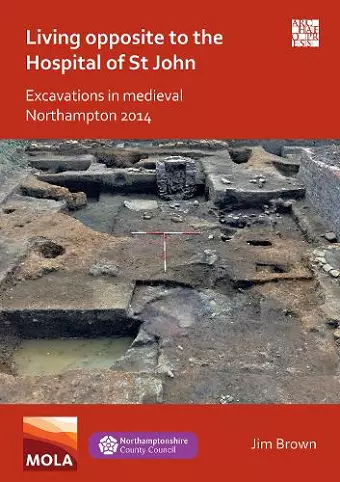Living Opposite to the Hospital of St John: Excavations in Medieval Northampton 2014
Format:Paperback
Publisher:Archaeopress
Published:10th Jun '21
Should be back in stock very soon

Living Opposite to the Hospital of St John: Excavations in Medieval Northampton 2014 presents the results of archaeological investigations undertaken on the site of new county council offices being built between St. John’s street and Angel Street, Northampton in 2014. The location was of interest as it lay directly opposite the former medieval hospital of St. John, which influenced the development of this area of the town.
Initially open ground situated outside the Late Saxon burh, the area was extensively quarried for ironstone during the earlier part of the 12th century, and by the mid-12th century, a few dispersed buildings began to appear. Domestic pits and a bread oven were located to the rear of Angel Street along with a carver’s workshop, which, amongst other goods, produced high-quality antler chess pieces. This workshop is currently without known parallel. The timber workshop was refurbished once and then replaced in stone by the mid-13th century. During the late 12th and early part of the 13th centuries, brewing and baking were undertaken in the two plots adjacent to the workshop. A stone building with a cobbled floor lay towards the centre of the St. John’s street frontage, and behind the building were four wells, a clay-lined tank for water drawn from the well, and several ovens, including at least two bread ovens and three malting ovens. This activity ceased at around the time that the carver’s workshop was replaced in stone, and much of the frontage was cleared.
Subsequently, although there was still one building standing on St. John’s street in the early 15th century, the former cleared ground was gradually incorporated back into the plots, perhaps as gardens adjoining the surviving late medieval tenement. The stone tenement was extended and refurbished in the late 15th century and was occupied until c. 1600. Another building was established on Fetter Street after c. 1450 but had disappeared by c. 1550. However, this is the first archaeological indication for the existence of Fetter Street, and further demarcation occurred in this period with a rear boundary ditch being established along the back of the Angel Street plot, separating the land to the south. In the 17th–18th centuries, the area was covered by the dark loamy...
'This very well-produced and highly informative volume reports chiefly on medieval deposits and sequences excavated in Northampton’s southern intramural zone, close to the Hospital and chapel of St John founded c 1140 and south of the Norman town’s central All Saints market. Prominent findings relate to quarrying for ironstone in the 12th century – to supply both city walls and hospital – plus industrial units, notably a bone- and ivory-carving workshop and a maltster’s complex.' – Neil Christie (2022): Medieval Archaeology, 66/2
‘Finalement, … une grande rigueur d’analyse, qui répond à celle de l’intervention de terrain guidée par des objectifs clairement définis … Il s’agit même d’un ouvrage quelque peu austère en raison de la nature des observations qui relèvent du caractère banal de la vie urbaine … qui ont été identifiées. … C’est dans cette normalité que réside l’intérêt de cet ouvrage qui donne à voir les résultats solides d’une opération archéologique de qualité dans une ville médiévale d’Europe de l’Ouest comme il en a existé des milliers. Les archéologues français comme du reste de l’Europe confrontés à ce même type d’occupation y trouveront de nombreux points de comparaison.’ [translated: Ultimately, there is … a great rigor of analysis, which corresponds to the fieldwork approach guided by clearly defined objectives… This is even a somewhat austere work due to the nature of the observations, which pertain to the mundane aspects of urban life … which have been identified. … It is in this normality that the value of this work lies, as it presents the solid results of a quality archaeological operation in a medieval town in Western Europe, similar to thousands of others that have existed. French archaeologists, as well as those from the rest of Europe, facing this same type of occupation, will find many points of comparison.]– Elisabeth Lorans (2024): Cahiers de civilisation médiévale
ISBN: 9781789699364
Dimensions: 290mm x 205mm x 19mm
Weight: 1270g
362 pages